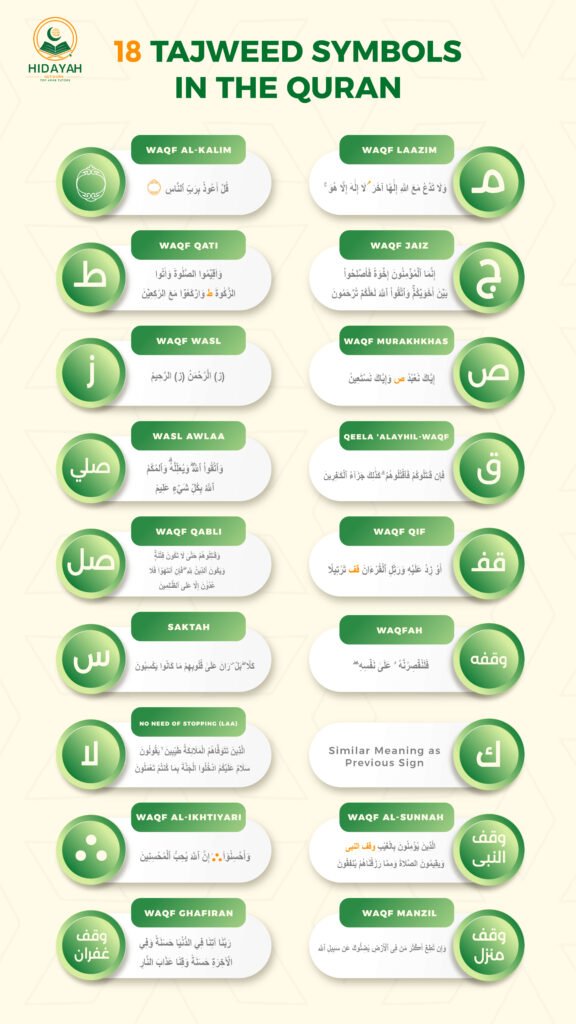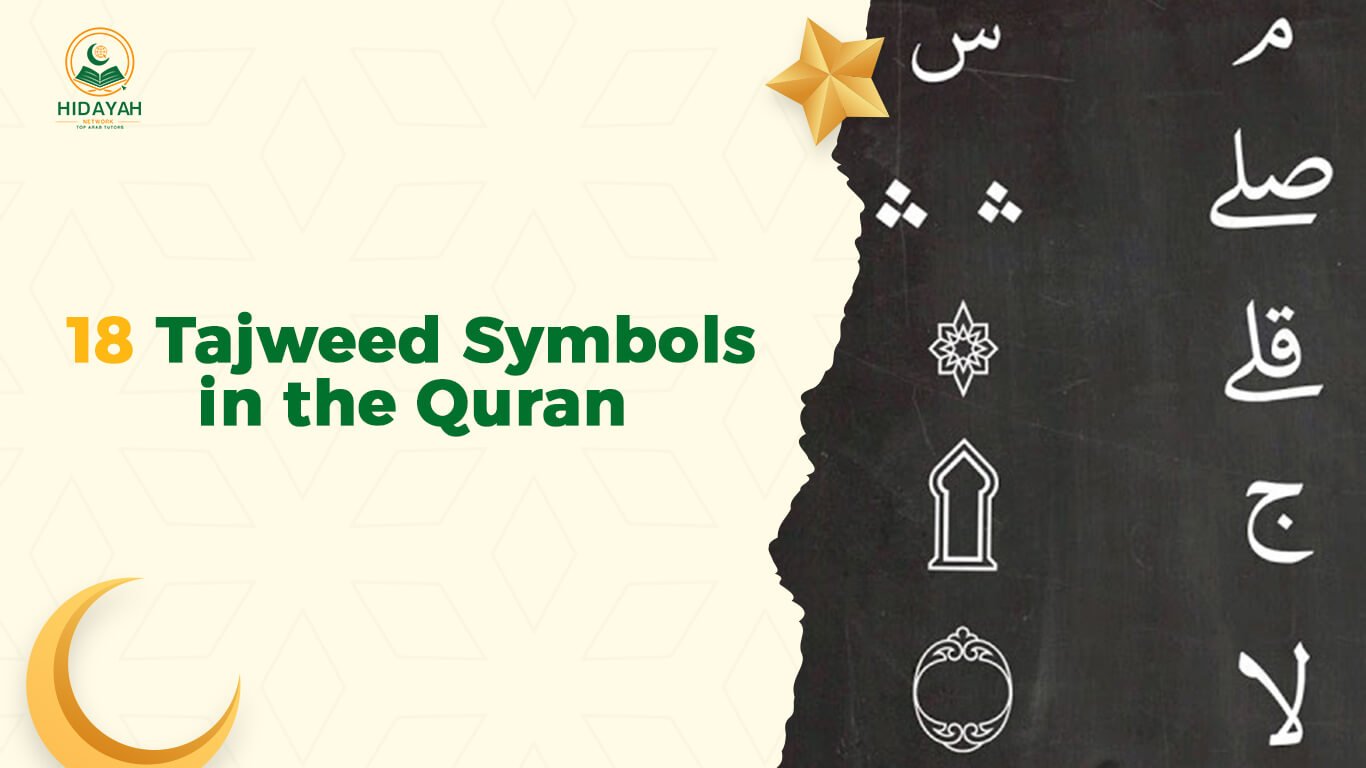Ever wondered about those symbols scattered throughout the Quran? Those are Tajweed markings, a guide to reciting the Quran beautifully and accurately.
This article will explore these symbols, explaining their meaning and how they affect recitation. From stopping points to pronunciation guides, we’ll explore the secrets to unlocking the proper reading of the Quran aligned with different types of Tajweed rules.

1. The Conclusion of Verse (Waqf al-Kalim)
The symbol , appearing as a small circle at the end of the verse, tells you that you’ve reached the end of that specific thought. It’s like reaching a full stop (.) at the end of a sentence in English.
Here, you should take a natural pause to breathe and reflect on the meaning you just read. This pause allows the message of the verse to settle in before you move on. Think about it like taking a small break between stanzas in a poem to appreciate its beauty.
Example:
قُلْ أَعُوذُ بِرَبِّ ٱلنَّاسِ
Here, the symbol appears at the end of each sentence, signifying a complete thought and a natural stopping point for reflection. Get started with learning Tajweed online today.
2. مـ – The Compulsory Stop (Waqf Laazim)
This symbol, marked as مـ, make a mandatory stop, just like the red light. Stopping here is crucial because continuing to recite without pausing might completely change the meaning of the verse. Think of it as a big pause that separates two very important ideas. It can better be understood as the comma in here: Stand not, sit!
Example:
وَلَا تَدْعُ مَعَ اللَّهِ إِلَٰهًا آخَرَ ۘ لَا إِلَٰهَ إِلَّا هُوَ ۚ
Here, the مـ symbol appears after the first sentence, after which the sovereignty of Allah that He is the only worthy of worship, not the other dieties that disbelievers claim to be worthy of worship, is proclaimed. one yu learn the Tajweed rules you could easily memorize Quran and become a Hafiz.
Get 40% OFF Now!
3. ط – The Absolute Pause (Waqf Qati)
Think of this symbol (ط) as a very strong pause, like the مـ but with an extra emphasis. Here, you not only stop but also slightly lower your voice. It’s used when there’s a clear shift in the subject or a dramatic effect is intended in the verse. It’s also a part of Meem Sakinah rules.
Example:
وَاَقِيۡمُوا الصَّلٰوةَ وَاٰتُوا الزَّكٰوةَ ط وَارۡكَعُوۡا مَعَ الرّٰكِعِيۡنَ
The ط symbol appears after Azzakaat and it is a natural pause where a sentence ends.
4. ج – The Permissible Stop (Waqf Jaiz)
This symbol (ج) indicates a place where you can pause, but it’s not mandatory. Stopping here depends on your breathing or how you want to emphasize certain words in the verse. It allows for some flexibility in recitation. In addition, it’s best to learn Idghaam rules for Tajweed.
Example:
إِنَّمَا ٱلۡمُؤۡمِنُونَ إِخۡوَةٞ فَأَصۡلِحُواْ بَيۡنَ أَخَوَيۡكُمۡۚ وَٱتَّقُواْ ٱللَّهَ لَعَلَّكُمۡ تُرۡحَمُونَ
Here, the ج symbol appears after the completion of a single thought. “The believers are but brothers, so make settlement between your brothers.” Then the next thought begins: “And fear Allah that you may receive mercy.”
5. ز – Continue Reading (Waqf Wasl)
This symbol (ز) in the juz and surahs tells you to keep reading without stopping. This is used when the meaning flows naturally between words or phrases, and stopping might disrupt the flow of the recitation. Pausing here would break the rhythm and potentially alter the intended meaning.
Example:
(ز) الَّرَّحْمَنُ (ز) الرَّحِيمُ
Here, in the 2nd verse of Surah Al-Fatiha, the absence of a pause symbol (ز) indicates Waqf Wasl. The meaning flows naturally from the Names of Allah ( الرحمن and رحيم) to their attribute, ملك يوم الدين (Maliki yawmid-din), which translates to “Ruler of the Day of Judgement.” Pausing after the Names would disrupt the connection between these ideas.
6. ص – The Licensed Pause (Waqf Murakhkhas)
The symbol ص indicates a place where you are permitted to take a pause, but similar to the Waqf Jaiz (ج), it’s not mandatory. Think of it like a yellow traffic light with a bit more leniency. You can pause here to catch your breath or for emphasis, but it’s not crucial for meaning. This pause allows for some flexibility in recitation style.
Key points about Waqf Murakhkhas:
- Optional pause, shorter than a Waqf Laazim (مـ) or Waqf Qati (ط).
- Useful for taking a breath or slightly emphasizing a word.
- Doesn’t significantly alter the meaning of the verse if you continue reading.
Example:
إِيَّاكَ نَعْبُدُ ص وَإِيَّاكَ نَسْتَعِينُ
Here, the ص symbol appears after the first sentence. You can pause briefly here to breathe before continuing with the next phrase, “You alone we worship, and You alone we seek help from,” However, continuing without a pause is also acceptable.
7. صلي – Preference for Continuation (Wasl Awlaa)
This symbol, صلي, isn’t as common as others but indicates where continuing the recitation is preferable to stopping. While a short pause might be possible, it’s generally discouraged because it could disrupt the flow of the verse.
Key points about Wasl Awlaa:
- Continuation is preferred over pausing.
- Stopping might break the natural flow of meaning.
- Pause should be very brief if necessary.
Example:
وَٱتَّقُواْ ٱللَّهَۖ وَيُعَلِّلَّهُۗ وَٱلمُكُمُ ٱللَّهُ بِكُلِّ شَيۡءٍ عَلِيمٞ
8. ق – Better not to Stop (Qeela ‘Alayhil-Waqf)
This symbol (ق) advises against stopping, but it’s not a strict prohibition like the Waqf Laazim (مـ). While technically you could pause here, it’s generally discouraged due to potential disruption of the meaning.
Key points about Qeela ‘Alayhil-Waqf:
- Stopping is discouraged, but not entirely forbidden.
- Pause should be minimal if unavoidable.
- Continuing ensures a smoother flow of the verse.
Example:
فَإِن قَـٰتَلُوكُمْ فَٱقْتُلُوهُمْ ۗ كَذَٰلِكَ جَزَآءُ ٱلْكَـٰفِرِينَ
9. صل – The Permissible Pause (Waqf Qabli)
The symbol صل (Waqf Qabli) might seem familiar after learning about Waqf Murakhkhas (ص). They both indicate places where pausing is allowed but with a subtle difference. While Waqf Murakhkhas allows a pause for breath control, Waqf Qabli offers a slightly longer permissible pause for emphasis or artistic effect.
Example:
وَقَـٰتِلُوهُمْ حَتَّىٰ لَا تَكُونَ فِتْنَةٌۭ وَيَكُونَ ٱلدِّينُ لِلَّهِ ۖ فَإِنِ ٱنتَهَوْا۟ فَلَا عُدْوَٰنَ إِلَّا عَلَى ٱلظَّـٰلِمِينَ
Understand the Madd and its types for Tajweed for beautiful Quran recitation.
10. قف – The Anticipation Mark (Waqf Qif)
The symbol قف (Waqf Waqf) acts like a pause button to create anticipation. It indicates a place to stop, but unlike the Waqf Laazim (مـ), stopping here doesn’t mark the end of a complete thought. Instead, it creates a dramatic pause before continuing with a related idea.
Example:
أَوْ زِدْ عَلَيْهِ وَرَتِّلِ ٱلْقُرْءَانَ قف تَرْتِيلًا.
11. س – The Silence Symbol (Saktah)
We’ve already encountered a symbol for stopping at the end of a verse (). The symbol س (Saktah) is similar but indicates a shorter pause within a verse. Think of it like a comma in English, marking a slight break for breath or to separate ideas within the sentence.
Example:
كَلَّا ۖ بَلْ ۜ رَانَ عَلَىٰ قُلُوبِهِمْ مَا كَانُوا يَكْسِبُونَ
Here, the س symbol appears in the red sign where you will stop for a short while like a comma sign and then continue the recitation.
13. لا – No Need of Stopping (Laa)
This symbol (لا) might surprise you – it actually indicates that you should not pause! It’s used in situations where stopping might disrupt the flow of the verse or alter the intended meaning.
Example:
الَّذِينَ تَتَوَفَّاهُمُ الْمَلَائِكَةُ طَيِّبِينَ ۙ يَقُولُونَ سَلَامٌ عَلَيْكُمُ ادْخُلُوا الْجَنَّةَ بِمَا كُنتُمْ تَعْمَلُونَ
The meaning flows naturally from worshiping1 Allah to seeking help from Him. Pausing in between might break the connection between these two acts of devotion.
14. ك – Similar Meaning as Previous Sign
The symbol ك might seem repetitive after learning about Laa (no stopping). Both indicate places where pausing is not recommended. However, there’s a subtle difference. Laa (لا) is a more general symbol used throughout the Quran, while (ك) is used less frequently and often emphasizes the importance of continuing the recitation for grammatical reasons.
15. ∴ – The Embracing Stop (Waqf al-Ikhtiyari)
The symbol ∴ (Waqf al-Ikhtiyari), also known as the “embracing stop,” indicates a place where pausing is optional, but doing so allows for deeper appreciation of the verse’s meaning and beauty.
Example:
وَأَنفِقُوا۟ فِى سَبِيلِ ٱللَّهِ وَلَا تُلْقُوا۟ بِأَيْدِيكُمْ إِلَى ٱلتَّهْلُكَةِ ۛ وَأَحْسِنُوٓا۟∴ ۛ إِنَّ ٱللَّهَ يُحِبُّ ٱلْمُحْسِنِينَ
Here, the ∴ symbol could appear after the question, “Then which of your Lord’s favors can you deny?” Pausing here allows the listener to reflect on the vastness of Allah’s blessings mentioned throughout the Surah. The pause adds weight to the question, urging contemplation.
16. وقف النبی – The Pause of Prophet PBUH (Waqf al-Sunnah)
This unique symbol (وقف النبی) signifies places where Prophet Muhammad (PBUH) himself is reported to have paused during his recitation. These pauses are not mandatory but hold historical significance and add depth to the recitation.
Example:
The specific location of Waqf al-Sunnah (وقف النبی) might vary depending on the narration. However, a common example is reported to be in:
الَّذِينَ يُؤْمِنُونَ بِالْغَيْبِ وقف النبی وَيقِيمُونَ الصَّلاةَ وَمِمَّا رَزَقْنَاهُمْ يُنفِقُونَ
Here, the symbol (وقف النبی) might appear after the first part, “Those who believe in the unseen.” According to some narrations, the Prophet (PBUH) would pause here, possibly to emphasize the importance of faith in the unseen before continuing with the following acts of worship.
17. وقف غفران – The Sign of Supplication (Waqf Ghafiran)
The term “وقف غفران” (Waqf Ghafiran) isn’t found directly in most classical Tajwid texts. However, some traditions discuss it as a place to pause for supplication (dua). It’s important to note that the scholarly opinions on the validity of this concept vary.
Example:
رَبَّنَا آتِنَا فِي الدُّنْيَا حَسَنَةً وَفِي الْآخِرَةِ حَسَنَةً وَقِنَا عَذَابَ النَّارِ
“Our Lord, grant us good in this world and good in the Hereafter and save us from the torment of the Fire.” (2:128)
18. وقف منزل – The Pause Sign of Jibrael (Waqf Manzil)
Similar to Waqf Ghafiran, the term “وقف منزل” (Waqf Manzil) isn’t found in classical Tajwid texts. It refers to places where Angel Jibril is narrated to have paused while teaching the Quran to Prophet Muhammad (PBUH).
Example:
وَإِن تُطِعۡ أَڪۡثَرَ مَن فِى ٱلۡأَرۡضِ يُضِلُّوكَ عَن سَبِيلِ ٱللَّه
What is the symbol of Tajweed in the Quran?
The Quran doesn’t have a single symbol for Tajweed. Instead, it uses a variety of markings to guide recitation. Some common symbols include:
- Stop signs: مثل (مثلًا: Waqf Laazim مـ) for mandatory pauses, and for verse endings.
- Pause signs: Like وقف (Waqf) for longer pauses within a verse, ص (Waqf Murakhkhas) for short optional pauses, and ∴ (Waqf al-Ikhtiyari) for pauses for reflection on beautiful verses.
- Flow signs: No symbol (like in إياك نعبد وإياك نستعين) indicates smooth recitation with no pause.
What is the basic Tajweed?
Basic Tajweed focuses on the correct pronunciation of Arabic letters and recitation rules in the Quran. Here’s a glimpse:
- Mastering the distinct sounds of Arabic letters is crucial. This includes understanding emphatic consonants, lengthened vowels, and proper pronunciation of the Quranic script.
- Quran recitation involves designated stopping points (Waqf) and smooth continuations (Wasl). Symbols like مـ for mandatory stops and no symbol for continuous flow guide the reciter.
- Vowels can be lengthened or shortened to alter pronunciation. For instance, Madd (مد) indicates extending specific vowels.
- Certain letters connect when recited together, while others require separation. Understanding these rules ensures a clear and beautiful recitation.
Final Words
With this knowledge of Tajweed symbols, you’re well on your way to elevating your Quran recitation! Remember, Tajweed is a journey, not a destination. Keep practicing, and you’ll not only improve your pronunciation but also deepen your connection with the beautiful words of the Quran.

About Author

